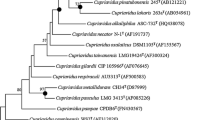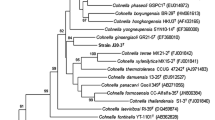Abstract
A Gram-stain negative, strictly aerobic, mesophilic bacterial strain, designated strain S23T, was isolated from pond-side soil of an artificial pond in South Korea. Cells were observed to be peritrichously flagellated short rods showing positive oxidase and catalase activities. Growth of strain S23T was observed at 15–37 °C (optimum, 30 °C), pH 5.0–9.0 (optimum, pH 7.0–8.0) and 0–2% (w/v) NaCl (optimum, 0–0.5%). The major respiratory quinone was identified as ubiquinone-8 and the major fatty acids were identified as C16:0, cyclo-C17:0, summed feature 3 (C16:1ω7c and/or C16:1ω6c) and summed feature 8 (C18:1ω7c and/or C18:1ω6c). The G + C content of the genomic DNA was determined to be 65.1 mol%. Phosphatidylglycerol, phosphatidylethanolamine and an unidentified phospholipid were detected as the major polar lipids. Phylogenetic analyses based on 16S rRNA gene sequences showed that strain S23T formed a phyletic lineage with Cupriavidus necator N-1T within the genus Cupriavidus. Strain S23T is closely related to C. necator N-1T (99.2%), Cupriavidus basilensis DSM 11853T (98.8%), Cupriavidus alkaliphilus ASC-732T (98.8%) and Cupriavidus numazuensis TE26T (98.7%), based on 16S rRNA gene sequence similarities. However, the DNA–DNA relatedness values between strain S23T and the closely related type strains were less than 46%. On the basis of phenotypic, chemotaxonomic and molecular properties, strain S23T represents a novel species of the genus Cupriavidus, for which the name Cupriavidus lacunae sp. nov. is proposed. The type strain is S23T (KACC 19624T = JCM 32674T).

Similar content being viewed by others
Abbreviations
- ANI:
-
Average nucleotide identity
- DDH:
-
DNA–DNA hybridization
- MP:
-
Maximum-parsimony
- ML:
-
Maximum-likelihood
- NJ:
-
Neighbor-joining
- Q-8:
-
Ubiquinone-8
References
Chang HW, Nam YD, Jung MY, Kim KH, Roh SW, Kim MS, Jeon CO, Yoon JH, Bae JW (2008) Statistical superiority of genome-probing microarrays as genomic DNA–DNA hybridization in revealing the bacterial phylogenetic relationship compared to conventional methods. J Microbiol Methods 75:523–530
Chun J, Oren A, Ventosa A, Christensen H, Arahal DR, da Costa MS, Rooney AP, Yi H, Xu XW, De Meyer S, Trujillo ME (2018) Proposed minimal standards for the use of genome data for the taxonomy of prokaryotes. Int J Syst Evol Microbiol 68:461–466
Coenye T, Goris J, De Vos P, Vandamme P, LiPuma JJ (2003) Classification of Ralstonia pickettii-like isolates from the environment and clinical samples as Ralstonia insidiosa sp. nov. Int J Syst Evol Microbiol 53:1075–1080
Cuadrado V, Gomila M, Merini L, Giulietti AM, Moore ER (2010) Cupriavidus pampae sp. nov., a novel herbicide-degrading bacterium isolated from agricultural soil. Int J Syst Evol Microbiol 60:2606–2612
da Silva K, Florentino LA, da Silva KB, de Brandt E, Vandamme P, de Souza Moreira FM (2012) Cupriavidus necator isolates are able to fix nitrogen in symbiosis with different legume species. Syst Appl Microbiol 35:175–182
Estrada-De Los Santos P, Martínez-Aguilar L, López-Lara IM, Caballero-Mellado J (2012) Cupriavidus alkaliphilus sp. nov., a new species associated with agricultural plants that grow in alkaline soils. Syst Appl Microbiol 35:310–314
Gomori G (1955) Preparation of buffers for use in enzyme studies. Methods Enzymol 1:138–146
Goris J, De Vos P, Coenye T, Hoste B, Janssens D, Brim H, Diels L, Mergeay M, Kersters K, Vandamme P (2001) Classification of metal-resistant bacteria from industrial biotopes as Ralstonia campinensis sp. nov., Ralstonia metallidurans sp. nov., and Ralstonia basilensis Steinle et al. 1998 emend. Int J Syst Evol Microbiol 51:1773–1782
Kageyama C, Ohta T, Hiraoka K, Suzuki M, Okamoto T, Ohishi K (2005) Chlorinated aliphatic hydrocarbon-induced degradation of trichloroethylene in Wautersia numadzuensis sp. nov. Arch Microbiol 183:56–65
Kim JM, Le NT, Chung BS, Park JH, Bae JW, Madsen EL, Jeon CO (2008) Influence of soil components on the biodegradation of benzene, toluene, ethylbenzene, and o-, m-, and p-xylenes by the newly isolated bacterium Pseudoxanthomonas spadix BD-a59. Appl Environ Microbiol 74:7313–7320
Kim M, Oh HS, Park SC, Chun J (2014) Towards a taxonomic coherence between average nucleotide identity and 16S rRNA gene sequence similarity for species demarcation of prokaryotes. Int J Syst Evol Microbiol 64:346–351
Komagata K, Suzuki K (1987) Lipid and cell-wall analysis in bacterial systematics. Methods Microbiol 19:161–208
Kumar S, Stecher G, Tamura K (2016) MEGA7: molecular evolutionary genetics analysis version 7.0 for bigger datasets. Mol Biol Evol 33:1870–1874
Lányi B (1987) Classical and rapid identification methods for medically important bacteria. Methods Microbiol 19:1–67
Lee I, Kim YO, Park SC, Chun J (2016) OrthoANI: an improved algorithm and software for calculating average nucleotide identity. Int J Syst Evol Microbiol 66:1100–1103
Makkar NS, Casida LE Jr (1987) Cupriavidus necator gen. nov., sp. nov.; a nonobligate bacterial predator of bacteria in soil. Int J Syst Evol Microbiol 37:323–326
Martínez-Aguilar L, Caballero-Mellado J, Estrada-de los Santos P (2013) Transfer of Wautersia numazuensis to the genus Cupriavidus as Cupriavidus numazuensis comb. nov. Int J Syst Evol Microbiol 63:208–211
Meier-Kolthoff JP, Auch AF, Klenk HP, Göker M (2013) Genome sequence-based species delimitation with confidence intervals and improved distance functions. BMC Bioinform 14:60
Minnikin DE, Patel PV, Alshamaony L, Goodfellow M (1977) Polar lipid composition in the classification of Nocardia and related bacteria. Int J Syst Bacteriol 27:104–117
Minnikin DE, O’Donnell AG, Goodfellow M, Alderson G, Athalye M, Schaal A, Parlett JH (1984) An integrated procedure for the extraction of bacterial isoprenoid quinones and polar lipids. J Microbiol Methods 2:233–241
Nadkarni MA, Martin FE, Jacques NA, Hunter N (2002) Determination of bacterial load by real-time PCR using a broad range (universal) probe and primers set. Microbiology 148:257–266
Nawrocki EP, Eddy SR (2007) Query-dependent banding (QDB) for faster RNA similarity searches. PLoS Comput Biol 3:e56
Richter M, Rosselló-Móra R (2009) Shifting the genomic gold standard for the prokaryotic species definition. Proc Natl Acad Sci U S A 106:19126–19131
Rosselló-Móra R, Trujillo ME, Sutcliffe IC (2017) Introducing a digital protologue: a timely move towards a database-driven systematics of archaea and bacteria. Antonie Van Leeuwenhoek 110:455–456
Sambrook J, Russell DW (2001) Molecular cloning: a laboratory manual, 3rd edn. Coldspring-Harbour Laboratory Press, Oxford
Sasser M (1990) Identification of bacteria by gas chromatography of cellular fatty acids, MIDI Technical Note 101. MIDI Inc, Newark
Sato Y, Nishihara H, Yoshida M, Watanabe M, Rondal JD, Concepcion RN, Ohta H (2006) Cupriavidus pinatubonensis sp. nov. and Cupriavidus laharis sp. nov., novel hydrogen-oxidizing, facultatively chemolithotrophic bacteria isolated from volcanic mudflow deposits from Mt. Pinatubo in the Philippines. Int J Syst Evol Microbiol 56:973–978
Smibert RM, Krieg NR (1994) Phenotypic characterization. In: Gerhardt P (ed) Methods for general and molecular bacteriology. American Society for Microbiology, Washington, DC, pp 607–654
Stackebrandt E, Ebers J (2006) Taxonomic parameters revisited: tarnished gold standards. Microbiol Today 33:152–155
Stackebrandt E, Frederiksen W, Garrity GM, Grimont PA, Kämpfer P, Maiden MC, Nesme X, Rosselló-Mora R, Swings J, Trüper HG, Vauterin L (2002) Report of the ad hoc committee for the reevaluation of the species definition in bacteriology. Int J Syst Evol Microbiol 52:1043–1047
Steinle P, Stucki G, Stettler R, Hanselmann KW (1999) Ralstonia basilensis sp. nov. In Validation of publication of new names and new combinations previously effectively published outside the IJSB, List no. 71. Int J Syst Bacteriol 49:1325–1326
Sun LN, Wang DS, Yang ED, Fang LC, Chen YF, Tang XY, Hua RM (2016) Cupriavidus nantongensis sp. nov., a novel chlorpyrifos-degrading bacterium isolated from sludge. Int J Syst Evol Microbiol 66:2335–2341
Vandamme P, Coenye T (2004) Taxonomy of the genus Cupriavidus: a tale of lost and found. Int J Syst Evol Microbiol 54:2285–2289
Vandamme P, Goris J, Coenye T, Hoste B, Janssens D, Kersters K, De Vos P, Falsen E (1999) Assignment of Centers for Disease Control group IVc-2 to the genus Ralstonia as Ralstonia paucula sp. nov. Int J Syst Bacteriol 49:663–669
Vaneechoutte M, Kämpfer P, De Baere T, Falsen E, Verschraegen G (2004) Wautersia gen. nov., a novel genus accommodating the phylogenetic lineage including Ralstonia eutropha and related species, and proposal of Ralstonia [Pseudomonas] syzygii (Roberts et al. 1990) comb. nov. Int J Syst Evol Microbiol 54:317–327
Yabuuchi E, Kosako Y, Yano I, Hotta H, Nishiuchi Y (1995) Transfer of two Burkholderia and an Alcaligenes species to Ralstonia gen. nov.: proposal of Ralstonia pickettii (Ralston, Palleroni and Doudoroff 1973) comb. nov., Ralstonia solanacearum (Smith 1896) comb. nov. and Ralstonia eutropha (Davis 1969) comb. nov. Microbiol Immunol 39:897–904
Yoon SH, Ha SM, Kwon S, Lim J, Kim Y, Seo H, Chun J (2017) Introducing EzBioCloud: a taxonomically united database of 16S rRNA and whole genome assemblies. Int J Syst Evol Microbiol 67:1613–1617
Funding
This work was supported by Korea Environmental Industry & Technology Institute (KEITI) through the Public Technology Program based on Environmental Policy (Project No. 2016000200012) and the Program for Collection of Domestic Biological Resources from the National Institute of Biological Resources (NIBR No. 2018-02-001) of the Ministry of Environment (MOE), Republic of Korea.
Author information
Authors and Affiliations
Contributions
CJ conceived the ideas and supervised all works. TF isolated strain S23T from a sample and TF and KK analysed the phenotypic and biochemical properties. JO performed the genomic analysis. TF, KK, and CJ wrote the manuscript and the manuscript has been reviewed and edited by all authors.
Corresponding author
Ethics declarations
Conflict of interest
The authors declare that they have no conflict of interest.
Ethical standards
This article does not contain any studies with human participants and/or animals performed by any of the authors.
Electronic supplementary material
Below is the link to the electronic supplementary material.
Rights and permissions
About this article
Cite this article
Feng, T., Kim, K.H., Oh, J. et al. Cupriavidus lacunae sp. nov., isolated from pond-side soil. Antonie van Leeuwenhoek 112, 543–551 (2019). https://doi.org/10.1007/s10482-018-1187-5
Received:
Accepted:
Published:
Issue Date:
DOI: https://doi.org/10.1007/s10482-018-1187-5




